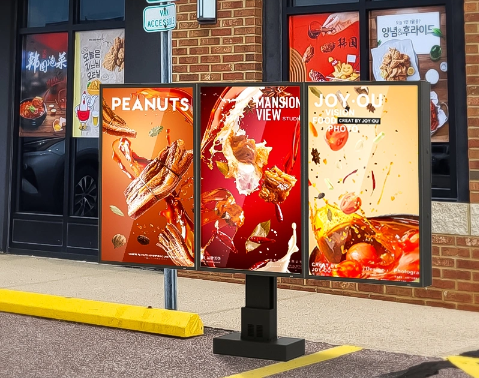To expand your news reach, consider advertising with our media partner, Patch Media, at https://heypapipromotionsmedia.town.news/. Patch is a nationwide news network comprising over 1,000 hyperlocal websites dedicated to community news across the United States. For press release distribution services, please call or visit https://heypapipromotions.com/advertise.
While traditional static signage has stood the test of time, the emergence of digital signage has introduced a wealth of new possibilities.
Transitioning from static to digital signs may initially appear daunting, with concerns about cost effectiveness. However, a thorough examination of the pros and cons of both static and digital signage can help navigate the available options.
Static Signage Overview:
Static signage encompasses printed signage that remains unchanged over time, including fixed signs, banners, posters, and billboards. It can also include manually updated signs such as blackboards or notice boards, as well as promotional signage like A boards.
Advantages of Static Signage:
Cost Efficiency: Initial production and installation costs are typically lower compared to digital displays, making static signage a budget friendly option for long term use.
Widely Available and Easily Created: Static signs can be readily produced and displayed in various locations, offering businesses flexibility in reaching their target audience.
Durability: Static signs are designed to withstand harsh weather conditions, ensuring visibility and longevity, especially for outdoor use.
Easy Maintenance: Once created, static signs require minimal upkeep compared to digital displays, with no software updates or connectivity issues to manage.
Disadvantages of Static Signage:
Limited Content: Static signs offer limited space for displaying information and cannot show dynamic content or real time updates, posing challenges for businesses requiring frequent changes.
Lack of Engagement: Static signs may struggle to capture and hold viewers' attention compared to dynamic digital displays, impacting their effectiveness in engaging audiences.
Limited Flexibility: Changes or updates to static signs require a new printing process and installation, lacking the quick and easy updates offered by digital signage.
Lower Visibility: In today's visually stimulating environment, static signs may be overshadowed by dynamic digital displays, potentially reducing their impact.
Digital Signage Overview:
Digital signage utilizes digital displays to communicate messages, offering dynamic content and engaging experiences for viewers. It encompasses various methods such as video walls, digital posters, and interactive displays.
Advantages of Digital Signage:
Dynamic Content: Digital signage allows for the display of dynamic content, including videos, animations, and real time updates, enhancing engagement and ensuring message freshness.
Flexibility: Businesses can easily change and update content across multiple screens using digital signage software, providing flexibility and consistency in messaging.
High Visibility: Digital displays are visually captivating, making them effective marketing tools for attracting attention and conveying important information.
Content Management Software: Dedicated software simplifies the management and scheduling of content, offering analytics and data to optimize signage strategy.
Improved Customer Engagement: Studies show that digital signage can increase footfall and sales, making it a cost effective solution for engaging customers.
Disadvantages of Digital Signage:
Higher Cost: Digital signage requires initial investment in displays, software, and content creation, resulting in higher upfront costs compared to static signage.
Energy Consumption: Digital displays consume more energy than static signs, although advancements in technology have made them more energy efficient over time.
Ambient Light: Bright ambient light can affect digital signage visibility, necessitating adjustments to brightness settings or the use of high quality displays.
Streaming Delays: Reliance on internet connectivity may lead to streaming delays or interruptions, affecting the delivery of real time content.
Conclusion:
Both static and digital signage offer unique advantages and disadvantages, and the choice between them depends on specific business needs, budget, and target audience. While static signage is simple, affordable, and durable, digital signage provides dynamic content, flexibility, and high visibility.
Business owners should carefully evaluate these factors to determine the most suitable signage solution for their needs, considering a combination of static and digital signage for maximum impact. Regardless of the chosen signage type, compelling content and relevance to the target audience remain key to successful marketing efforts.
For businesses interested in digital signage, EKAA offers an easy to use software solution to create engaging displays and connect with customers effectively. With a range of features and templates, EKAA helps businesses harness the power of digital signage to drive engagement and achieve their marketing goals.
Increase Business Visibility with Outdoor Digital Signage
In general, outdoor digital signage for business offers numerous benefits and opportunities for engaging with customers and promoting your brand effectively.
Outdoor digital kiosk for organizations enhances visibility and exposure, attracting greater customers and foot traffic. By way of showing dynamic content material in actual time, companies can interact with their target market efficaciously and tailor their messaging to specific demographics.
Moreover, outdoor digital display board is a fee powerful advertising answer in comparison to conventional strategies like print or T.V. Ads. With the ability to easily update content material and goal specific audiences, companies can achieve a higher go back on investment and experience extra flexibility in their advertising techniques.
The Blessings of Outdoor Digital Signage for Agencies
Outdoor digital display board plays a critical position in enhancing the visibility and publicity of corporations, drawing in greater foot visitors and boosting income. Via strategically setting those electronic shows in high site visitors regions, companies can capture the attention of passersby and potential clients.
One of the key advantages of making use of outdoor virtual signage is the potential to show off dynamic content and promotions in real time. This lets in agencies to tailor their messaging to unique audiences and hold them engaged with clean and applicable records. Whether or not it is selling a new product, saying a sale, or sharing important updates, digital signage gives a versatile platform for effective communique.
Furthermore, outdoor virtual signage proves to be a cost effective advertising and marketing answer while as compared to conventional methods like print or T.V. Ads. With the ability to easily replace content material and goal precise demographics, businesses can obtain a better return on investment and revel in greater flexibility of their advertising techniques.
FAQs about Outdoor Digital Signage for Business
What are the main benefits of using outdoor digital signage for business?
Outdoor digital signage can significantly increase visibility and exposure to potential customers, helping businesses attract more foot traffic and drive sales. Businesses can showcase dynamic content and promotions on outdoor digital signage, allowing for real time updates and targeted messaging to engage with their audience effectively. Utilizing outdoor digital signage is a cost effective advertising solution compared to traditional methods such as print or TV ads, offering a higher return on investment and greater flexibility in changing content.
How can outdoor digital signage help businesses attract more customers?
Outdoor digital signage can increase visibility and exposure to potential customers by showcasing dynamic content and promotions. This can help businesses attract more foot traffic and drive sales by engaging with their audience effectively through targeted messaging and real time updates.
Is outdoor digital signage a cost effective advertising solution for businesses?
Yes, utilizing outdoor digital signage is a cost effective advertising solution for businesses compared to traditional methods such as print or TV ads. It offers a higher return on investment and greater flexibility in changing content, making it a valuable tool for businesses looking to enhance their visibility and reach a wider audience.
The technology continues to evolve, digital message board outdoor is poised to play an increasingly integral role in shaping the future of navigation for business. For further information about commercial outdoor digital signage displays, please contact EKAA!!!



